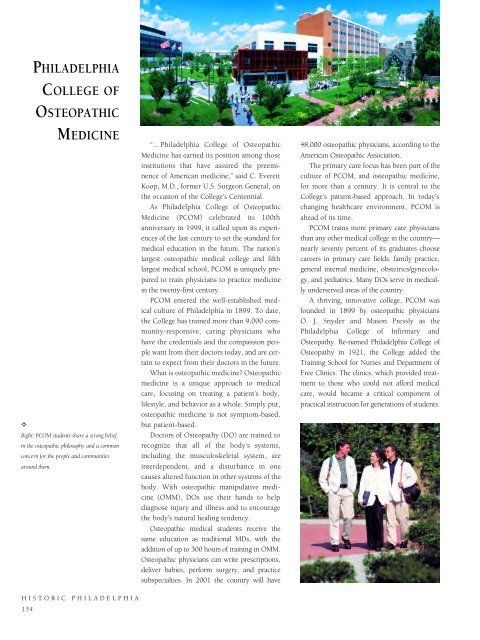Historic Philadelphia
An illustrated history of the city of Philadelphia, paired with the histories of companies, families and organizations that make the region great.
An illustrated history of the city of Philadelphia, paired with the histories of companies, families and organizations that make the region great.
You also want an ePaper? Increase the reach of your titles
YUMPU automatically turns print PDFs into web optimized ePapers that Google loves.
PHILADELPHIA<br />
COLLEGE OF<br />
OSTEOPATHIC<br />
MEDICINE<br />
✧<br />
Right: PCOM students share a strong belief<br />
in the osteopathic philosophy and a common<br />
concern for the people and communities<br />
around them.<br />
HISTORIC PHILADELPHIA<br />
154<br />
“…<strong>Philadelphia</strong> College of Osteopathic<br />
Medicine has earned its position among those<br />
institutions that have assured the preeminence<br />
of American medicine,” said C. Everett<br />
Koop, M.D., former U.S. Surgeon General, on<br />
the occasion of the College’s Centennial.<br />
As <strong>Philadelphia</strong> College of Osteopathic<br />
Medicine (PCOM) celebrated its 100th<br />
anniversary in 1999, it called upon its experiences<br />
of the last century to set the standard for<br />
medical education in the future. The nation’s<br />
largest osteopathic medical college and fifth<br />
largest medical school, PCOM is uniquely prepared<br />
to train physicians to practice medicine<br />
in the twenty-first century.<br />
PCOM entered the well-established medical<br />
culture of <strong>Philadelphia</strong> in 1899. To date,<br />
the College has trained more than 9,000 community-responsive,<br />
caring physicians who<br />
have the credentials and the compassion people<br />
want from their doctors today, and are certain<br />
to expect from their doctors in the future.<br />
What is osteopathic medicine? Osteopathic<br />
medicine is a unique approach to medical<br />
care, focusing on treating a patient’s body,<br />
lifestyle, and behavior as a whole. Simply put,<br />
osteopathic medicine is not symptom-based,<br />
but patient-based.<br />
Doctors of Osteopathy (DO) are trained to<br />
recognize that all of the body’s systems,<br />
including the musculoskeletal system, are<br />
interdependent, and a disturbance in one<br />
causes altered function in other systems of the<br />
body. With osteopathic manipulative medicine<br />
(OMM), DOs use their hands to help<br />
diagnose injury and illness and to encourage<br />
the body’s natural healing tendency.<br />
Osteopathic medical students receive the<br />
same education as traditional MDs, with the<br />
addition of up to 300 hours of training in OMM.<br />
Osteopathic physicians can write prescriptions,<br />
deliver babies, perform surgery, and practice<br />
subspecialties. In 2001 the country will have<br />
48,000 osteopathic physicians, according to the<br />
American Osteopathic Association.<br />
The primary care focus has been part of the<br />
culture of PCOM, and osteopathic medicine,<br />
for more than a century. It is central to the<br />
College’s patient-based approach. In today’s<br />
changing healthcare environment, PCOM is<br />
ahead of its time.<br />
PCOM trains more primary care physicians<br />
than any other medical college in the country—<br />
nearly seventy percent of its graduates choose<br />
careers in primary care fields: family practice,<br />
general internal medicine, obstetrics/gynecology,<br />
and pediatrics. Many DOs serve in medically<br />
underserved areas of the country.<br />
A thriving, innovative college, PCOM was<br />
founded in 1899 by osteopathic physicians<br />
O. J. Snyder and Mason Pressly as the<br />
<strong>Philadelphia</strong> College of Infirmary and<br />
Osteopathy. Re-named <strong>Philadelphia</strong> College of<br />
Osteopathy in 1921, the College added the<br />
Training School for Nurses and Department of<br />
Free Clinics. The clinics, which provided treatment<br />
to those who could not afford medical<br />
care, would became a critical component of<br />
practical instruction for generations of students.
















